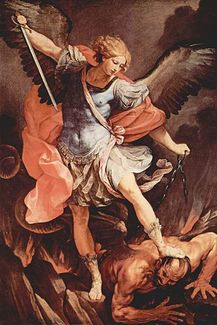 The meaning of the Requiem text, part 5:
The meaning of the Requiem text, part 5:
You, who absolved Mary,
and listened to the thief,
give me hope also.
We are told in the accounts of the Crucifixion that Jesus was put between two thieves, thus signifying that he was considered the lowest of the low. This method of execution was reserved for that category anyway. We have the actual conversation to which the “Recordare” refers only in the Gospel of Luke:
One of the criminals who hung there hurled insults at him: “Aren’t you the Messiah? Save yourself and us!” But the other criminal rebuked him. “Don’t you fear God,” he said, “since you are under the same sentence? We are punished justly, for we are getting what our deeds deserve. But this man has done nothing wrong.” Then he said, “Jesus, remember me when you come into your kingdom.” Jesus answered him, “Truly I tell you, today you will be with me in paradise” (23:39-43).
Several interesting concepts are displayed in this short passage: First of all, the so-called “penitent thief” or, as he’s sometimes called, “good thief,” seems to know something about Jesus, since he clearly references several ideas: Jesus is being killed unjustly and has a kingdom. In a very real sense, the thief recognizes Jesus’ power to forgive sins. This scene, covering only four verses in one Gospel, raises all sort of interesting questions: How did the thief know who Jesus was? Had he perhaps heard Jesus’ teaching? Had he become a follower of Jesus in some way before this scene? We don’t know. The passage simply says that he asks to be remembered and is assured that he will indeed be in Paradise that very day, after his death. These verses are often used to illustrate the Christian doctrine of salvation by grace and faith alone, not by works, as the thief has no chance to do anything, but only to believe and accept.
So how does this story fit into the context of the “Recordare”? The title of this section means “remember,” and it’s a request:
Remember, kind Jesus,
my salvation caused your suffering;
do not forsake me on that day.
The speaker of these words echoes the words of the thief: “Remember me.” If, he says, the thief was listened to, then he claims that same grace for himself. This theme is repeated over and over in the Requiem text: the speaker repents of his sins and asks for mercy, asks to be spared from the coming judgment. I think one of the most touching examples of these ideas comes in the “Rex tremendae” section that immediately precedes the “Recordare”: in the midst of the dramatic depiction of God as the “King of tremendous majesty,” we suddenly have the plaintive words “salve me”–”save me.”
On to Michael, who appears in the “Domine Jesu” as someone who will usher penitents into the presence of God:
Let the standard-bearer, holy Michael,
bring them into holy light.
The reference is to Michael the archangel, as he is called in the New Testament book of Jude. This being is also mentioned three times in the Jewish Bible/Old Testament book of Daniel and in the final book of the Bible, Revelation, where he leads the angelic hosts against Satan. The only other angel mentioned by name in the Bible is Gabriel, who makes several appearances, always as a messenger. There seems to be some sort of ranking within angels, but the whole system isn’t spelled out. One thing is for sure: the images we have of angels of much of our art bears little or no resemblance to the actual angels in Scripture. As a former pastor of mine has pointed out, the most common reaction in the Bible to the appearance of an angel is abject fear. Remember what the first statement of the angels to the shepherds is? “Fear not.” (So the rather sweet-faced, curly-haired version of Michael in the illustration for this post is certainly nowhere near reality.)
As time went on in church history, Michael came to be more and more honored, often being called “Saint Michael.” Churches were dedicated to him, prayers were made to him, devotions were paid. This veneration doesn’t fit into the biblical attitude towards angels in general; in fact, at least one passage specifically commands that angels not be worshipped:
At this I fell at his feet to worship him. But he said to me, “Don’t do that! I am a fellow servant with you and with your brothers and sisters who hold to the testimony of Jesus. Worship God! (Rev. 19:10).
Can’t get much clearer than that. And indeed our text portrays Michael in this way, as a servant or messenger. (Almost an usher, dare I say?) What matters is the “holy light” of God’s presence.
So these two very different characters in the Requiem, the condemned thief and the exalted angel, look for the same goal: the presence and kingdom of God. Next up: the association between God and light.

